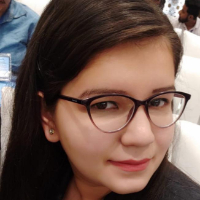
- Trending Categories
 Data Structure
Data Structure Networking
Networking RDBMS
RDBMS Operating System
Operating System Java
Java MS Excel
MS Excel iOS
iOS HTML
HTML CSS
CSS Android
Android Python
Python C Programming
C Programming C++
C++ C#
C# MongoDB
MongoDB MySQL
MySQL Javascript
Javascript PHP
PHPPhysics
Chemistry
Biology
Mathematics
English
Economics
Psychology
Social Studies
Fashion Studies
Legal Studies
- Selected Reading
- UPSC IAS Exams Notes
- Developer's Best Practices
- Questions and Answers
- Effective Resume Writing
- HR Interview Questions
- Computer Glossary
- Who is Who
Sunidhi Bansal has Published 1100 Articles

Sunidhi Bansal
969 Views
We are given an array of integers. The goal is to find the count of elements of an array which are less than or equal to the given value K.Input Arr[]= { 1, 2, 3, 14, 50, 69, 90 } K=12Output Numbers smaller or equal to K: 3Explanation Numbers 1, 2, 3 is ... Read More

Sunidhi Bansal
305 Views
We are provided two numbers START and END to define a range of numbers.The goal is to find all the numbers in the range [START, END] which have no digit as 0 and have sum of digits equal to a given number N. Also the numbers are divisible by MWe ... Read More

Sunidhi Bansal
236 Views
We are provided two numbers START and END to define a range of numbers.The goal is to find all the numbers in the range [START, END] which have sum of digits equal to a given number Y.We will do this by traversing numbers from START to END and for each ... Read More

Sunidhi Bansal
2K+ Views
We are given two numbers A and B. Also provided two numbers START and END to define a range of numbers. The Ath tile has paint white and Bth tile has paint black. If the tile is painted both black and white then it turns grey. The goal is to ... Read More

Sunidhi Bansal
475 Views
We are provided two numbers N which defines a range [1, N] and D which is a difference.The goal is to find all the numbers in the range [1, N] such that the [ number - (sum of its digits) ] > D. We will do this by traversing numbers ... Read More

Sunidhi Bansal
110 Views
We are provided two numbers START and END to define a range of numbers.The goal is to find all the numbers in the range [START, END] that are divisible by all of its non-zero digits . We will do this by traversing numbers from START to END and for each ... Read More

Sunidhi Bansal
530 Views
We are provided a number N. The goal is to find the numbers that are divisible by X and not by Y and are in the range [1, N].Let’s understand with examples.Input N=20 X=5 Y=20Output Numbers from 1 to N divisible by X not Y: 2Explanation Only 5 and 15 are divisible by ... Read More

Sunidhi Bansal
503 Views
We are provided two numbers START and END to define a range of numbers. And also an array of positive numbers Arr[]. The goal is to find all the numbers that are divisible by all elements of Arr[] and are in the range [START, END] .Method 1 ( Naive Approach ... Read More

Sunidhi Bansal
2K+ Views
We are provided a number N. The goal is to find the numbers that have 0 as digit and are in the range [1, N].We will do this by traversing numbers from 10 to N ( no need to check from 1 to 9 ) and for each number we ... Read More

Sunidhi Bansal
644 Views
We are provided two numbers START and END to define a range of numbers. The goal is to find the numbers that have only 2 and 3 as their prime factors and are in the range [START, END].We will do this by traversing numbers from START to END and for ... Read More
